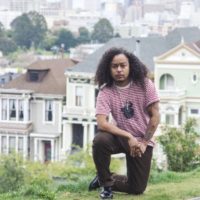As an Indigenous writer and artist, I believe in honoring my heartwork through reciprocity. For me, one means of giving and receiving has been sharing the work of other Indigenous artists and uplifting them however I can. I’m grateful to The Rumpus for providing us a space during Native American Heritage Month and for letting me curate this space each November. This year, I wanted to take my role a step forward by offering a fellow poet a chance to co-curate. I first met Cuauhtémoc when they were a freshman at Stanford; I was their RA. Cuauhtémoc was an artist from the beginning; the first time I saw them dance it was poetry, it was image and metaphor in motion, and I am grateful they continue to dance and write poetry. I look forward to you learning more about them and their heartwork.
– Tanaya Winder
This is a dark time in which we find ourselves, but such times are not unusual to the Indigenous writer, to the Native American storyteller. To us, a pandemic, a disease, a breaking of civility, Black lives dehumanized and undervalued, and erasure of our land and our stewards, our protectors of sacred spaces, is not unusual—it is continued oppression to our people as a result of colonial heteronomative patriarchal capitalism. And yet, we Indigenous writers continue to find beauty. And more, us queer Indigenous artists find and experience love, innovate new ways to sing and dance in our poetic expressions, and bridge communities with story, so that futures of unity can be invoked. This is how we continue. This is how we continue… This is how we resist. This is how we persist and thrive…
In honor of Native American Heritage Month I dance, celebrate, and uplift several queer and two-spirit Indigenous writers whose work tells us the stories often unheard, gone missing, yet behold and begin to complete our full truth.
It is urgently necessary to look to our femmes, our gender non-conforming, our two-spirit ancestors and contemporaries, for guidance in solving our biggest issues, and sharing our smallest, most intimate words. It is urgently necessary to listen, and be open to our queer and transgender Indigenous words—for they are unfortunately still unusual, but, thus, provide us with space to renew, reclaim, and replenish our resistance. May these works find your stirring and stir you some more… As a cihuaiyolo butch queen, a Mescalero Apache, a Mexika-Chichimeca/Cano writer and curator, I continue to trouble my own understanding of what I can do to practice innovation in myself and in my social justice. I think to the land and the sky, to the wildfires in our forests, and the hurricanes of the oceans, that we must start to build together new ways of experiencing, and healing each other—non-human bodies included.
Here, with you, we start with poems, stories, words, readings, writings…
– Cuauhtémoc Peranda
***
About black and native echolocation in the time of corona
i.
I’m always amazed at how indigenous people find each other
I reckon it is all we’ve ever known
the answer is in the water
down where the sky people sent us to incubate
since earth is accelerated lightwork
We are learning so quick and sloppy that other astral travelers lock their spaceship doors when driving by our planet
they overt their eyes because we are the sundown town of the milky way
ii.
the stars tell me we are stuck at the galactic kid’s table due to our badass ways
however, some of us chose to come here
to do work on ocean floors where there is healing
oh, just imagine the love for humanity it takes to be incarnated black
to risk swimming to land to support everyone and their literal mamas
iii.
sharing the waters of our finding
knowledge of whales singing praise songs
octopi teaching telekinesis
fighting lessons from rainbow mantis shrimps
With our hair ties made out of kelp
And flat-chested crab goons protecting the block
let these mermaids keep singing white sailors to their deaths
***
Photograph of Mason J. by Marcella Sanchez.




